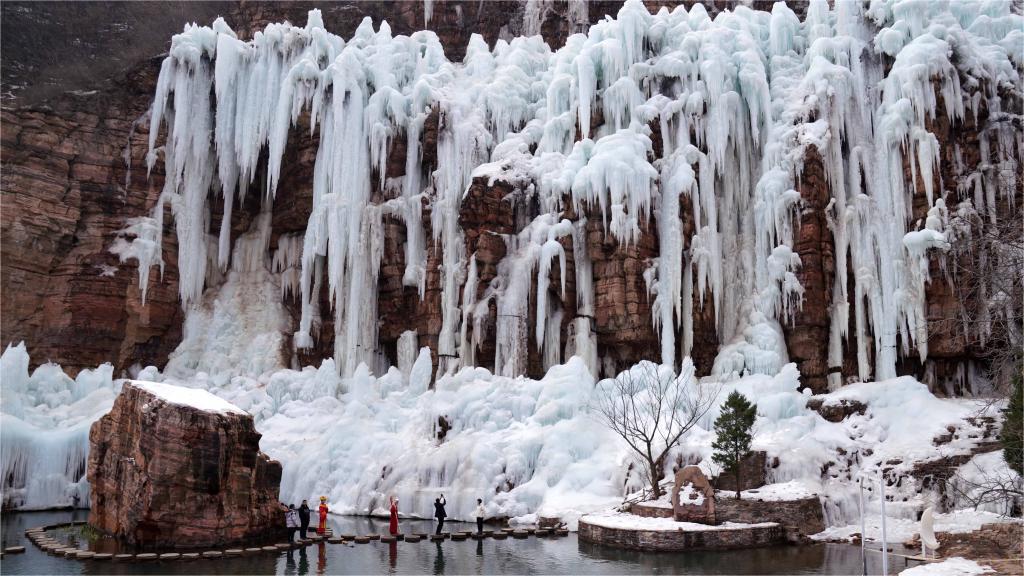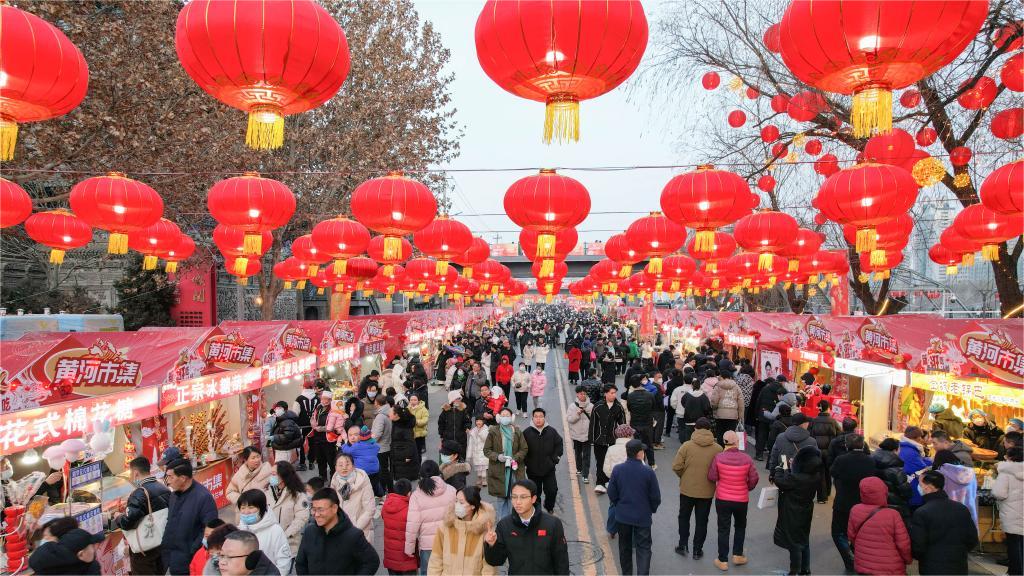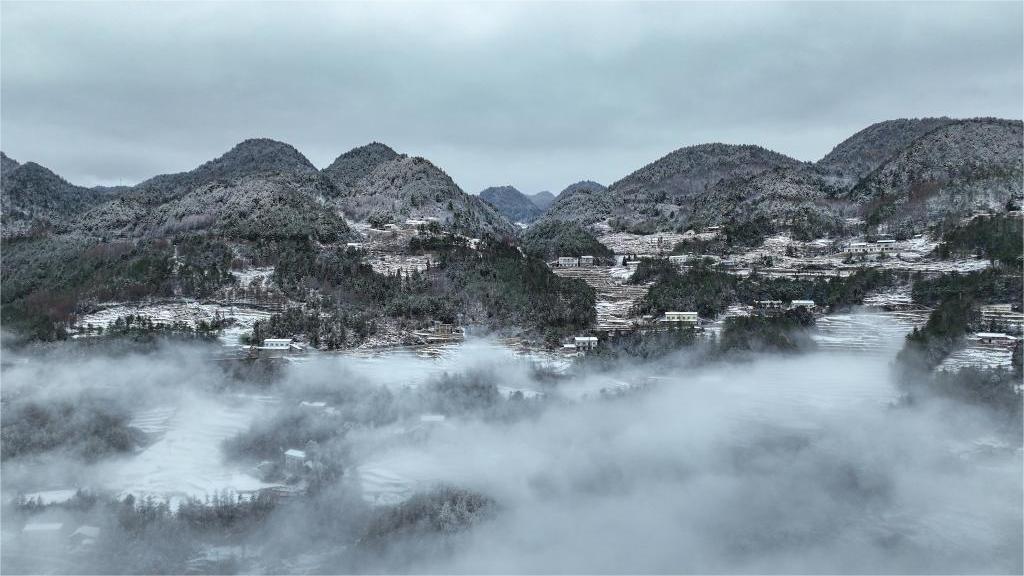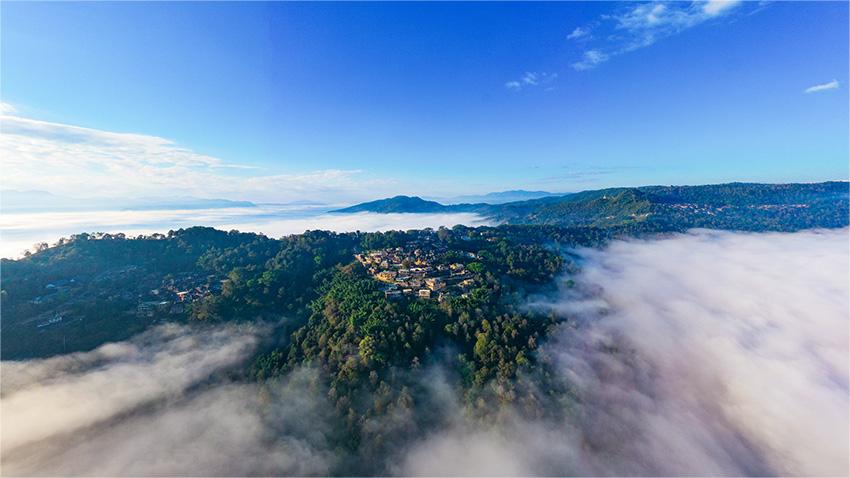Beijing illuminates new winter tourism
On a bitterly cold Beijing evening in late November, 27-year-old Li Chuhan was one of thousands of spectators mesmerized by a light show that looked like spectacular scenes from a Harry Potter movie.
A flock of illuminated giant phoenixes — trailing long, fiery tail feathers — circled, soared and swooped over the lake near the Solana shopping mall in Chaoyang district.
Dressed in a thick coat and holding a camera, Li was surrounded by a group of people and jostled to capture images of the phoenixes, which in mythology are reborn through fire and ashes.
The simulated phoenixes that transfixed the crowd during the Beijing Chaoyang International Light Festival were "kites" powered by drones with a series of lights attached.
The festival, held along the Liangma River and across other landmark locations in Chaoyang, featured more than 100 cultural, commercial and tourism events.
Although she was chilled to the bone as she clutched her camera, Li said she hoped more light shows would be held in Beijing in the winter. "It's only on rare occasions that wintry days like these don't dampen people's enthusiasm to go out," she said, adding the night was a precious moment that lifted her spirits.
When it comes to winter spectacles, Harbin in Heilongjiang province traditionally captures the public imagination with its exhibitions of elaborate ice and snow sculptures. However, Beijing is catching up fast. Dazzling light displays in bustling commercial areas, augmented by lanterns hung on suburban trees for Chinese New Year, are trending topics on social media.
A large number of fish lanterns shining blue light on trees lit purple, nicknamed "Big Fish and Begonia" by netizens, have been praised for creating a cool urban atmosphere in Chaoyang's Sanlitun area. Other attractions that have gained attention include glowing spherical lights floating on the Liangma River in Chaoyang that twinkle in various colors, and clusters of red and yellow lights adorning trees in Moshikou Street in western Shijingshan district to welcome the arrival of Chinese New Year.
Shining examples
Experts are hopeful the city's displays, set against the backdrop of modern and older buildings, will prove to be another popular winter tourism attraction.
Li Li is the director of the Light and Shadow Center at the China Academy of Urban Planning and Design's Beijing Planning and Design Consultants Co, the major design institute responsible for the light show in Chaoyang. She believes the multicolored light displays and accompanying performances have added vibrancy to the city's winter skies.
"We wanted a pyrotechnic atmosphere that contrasts with the traditional cold, reinforced concrete image of a metropolis," she said. "We aimed to bring relaxation and pleasure rather than tension and stress to the business districts in Beijing, further restoring the city's charm during winter nights."
According to Li Li, the light shows complement the city's architecture and culture, and strengthen the image of urban cultural districts.
Li Chuhan, the engineer, said that she had never seen such a large number of people on the streets near Solana in winter. Visitors were crammed together as they crossed bridges over the Liangma River, and security guards used megaphones to ensure that the crowds moved safely.
Li Chuhan studied electrical engineering in Nanjing, Jiangsu province, from 2019 to 2022. She recalled that during Chinese New Year, the annual Qinhuai Lantern Festival held along scenic streets near the Confucius Temple added sparkle to the city's celebrations.
Although a Beijing native, she said in the past she had seldom attended lantern fairs in the city due to them being few in number and usually having lackluster decorations.
However, the light show on the Liangma River helped change her mind.
"Unlike the usual displays, the lighting along the river enthralled me," she said. "At a pier, light projections were cast on the wall of a building, constantly changing with the music, creating an artistic atmosphere that made me feel relaxed and joyful.
"That night, the river and shopping mall took on a chic appearance under the lights, with the architecture and nearby walking trails looking like the city of my dreams," Li Chuhan added.
Magical Moshikou
The red lanterns adorning Moshikou Street in Shijingshan district have also struck a chord with Beijingers and visiting tourists.
On the lifestyle-sharing platform Xiaohongshu, the hashtag "Moshikou" has generated more than 1.16 million views and the topic "Moshikou Street" has amassed over 780,000 views.
Taking pictures at dusk of the Moshikou Street lanterns has become a major trend on social media.
Zeng Huifan, 33, was among those who shared her posts on Xiaohongshu shortly after she visited the street at night.
Inspired by the approaching Chinese New Year, Zeng, an amateur photographer, decided in early January to capture the allure of the red lanterns.
"It's rare to find a place with such a large number of lanterns in Beijing as those areas have been eclipsed by the proliferation of high-rise buildings," she said.
Trees glittering with lanterns form a spectacular scene along the 1,500-meter stretch of Moshikou Street. Stores and stalls on the sides of the road offer culinary treats such as sesame flatbread, mutton soup, sugarcoated haws, and dumplings, adding to the hustle and bustle of the suburban setting.
"The entire street is very clean and full of a festive vibe for Spring Festival," said Zeng. "I got there around 5 pm on a Saturday last month, waited for the sunset for about half an hour, and took pictures of lanterns with a DSLR (digital single lens reflex) camera for about 20 to 30 minutes.
"I've been living in Beijing for 18 years, and it was the first time that I paid attention to Moshikou Street, which amazed me with its festive air and artistic wall paintings," she said. "To my recollection, a place like Moshikou has seldom been seen in the city."

Visitors enjoy the annual Longqing Gorge Ice Lantern Festival in Beijing's northwestern Yanqing district. [ZOU HONG/CHINA DAILY]
Ice lanterns
Another popular event — the annual Longqing Gorge Ice Lantern Festival in Beijing's northwestern Yanqing district — had attracted more than 60,000 tourists by the end of last month. Dragon-themed elements were integrated into the ice and snow sculptures to convey blessings and good fortune for the Year of the Dragon.
"A large number of dragon-related festive lanterns were set up for tourists. Folk tales based on the dragon became the main themes of this year's ice lantern design," said Zhang Haijun, head of the Yanqing Office of Ice Lanterns, who is also the designer and coordinator of the 38th Longqing Gorge Ice Lantern Festival, which runs from Jan 15 to Feb 28.
One of the features of the event is a 120-meter-long gold dragon-shaped lantern placed on the top of a mountain to welcome tourists.
Zhang said the festival, sprawling across 250,000 square meters this year, has many spectacular displays for visitors.
"We created numerous photo opportunities for tourists, basically one every 50 meters along the tour route," he said. Some game characters loved by young people were also incorporated into the ice sculptures, he added.
Three ice sculptures of female cartoon characters caught the attention of children visiting the festival. Li Yitong, a 9-year-old from Haidian district, said she liked the originality and novelty of the sculptures.
"There are different colors on every cartoon sculpture — green, pink and blue — which made the characters look so real," said Li Yitong. "I would touch them if there were no barriers."
Her mother, Zhao Jiana, who drove for about an hour to take her daughter to the event, said the novel elements of this year's festival are likely to have increased the number of visitors.
Zhao said her daughter also joined a group of children who performed a dance in an open space at the Longqing Gorge scenic area. "She was so happy that she even forgot about the freezing cold temperature that day," Zhao said.
Zhang, the head of the ice lantern office, said a glacier waterfall, which is about 26 meters high and has snow monsters and polar bears at the bottom, is another popular attraction at this year's festival.
"Our ice lantern festival is not a knockoff of the Harbin Ice and Snow World but rather another event located near Beijing, which makes the visitors feel they are in the Arctic," he said.

Lights adorn buildings along Liangma River during the Beijing Chaoyang International Light Festival this winter. [CHINA DAILY]
Learning experience
The lights have already dimmed on the Beijing Chaoyang International Light Festival, which ran from Nov 18 to Dec 9.
However, how such modern light shows can be integrated with traditional lantern fairs to create long-term attractions is still being considered by experts and event organizers.
As an offseason tourism event, the Chaoyang light show encouraged tourists to linger longer in Beijing, but greater efforts are needed from local authorities and business owners to build on that success.
"In fact, Beijing's weak point is its cold weather in winter, and the night economy has been affected over the past few years," said Xiong Haifeng, an associate professor with the School of Cultural Industries Management at the Communication University of China.
"This year's light show has spawned new business models and offered immersive experiences for tourists, thus having an integrated and comprehensive impact."
While Beijing has taken initial steps on tourism initiatives this winter, finding effective solutions to further stimulate urban vitality in the cold months and boost the night economy requires more exploration, he said.
However, light shows have a natural advantage in attracting people, Xiong said. Chasing a light source is embedded in the human psyche, with illumination giving people a sense of warmth and security.
"Fundamentally, a light show fulfills people's inner emotional needs for the pursuit of a better life and greater expectations," Xiong said.
This winter's light displays in Beijing had also gone beyond "illumination and beautification" to express the city's values and aspirations, he added.
"The light show was by no means a mere display of high-tech skills. It integrated design with the urban landscape and cultural roots to resonate with the visitors," he said.
Photos
Related Stories
- Winter sports in China eye white-hot growth
- Interview: Australia hopes China to be its top tourism market again, says tourism chief
- Beijing parks receive over 10 mln visitors during Spring Festival holiday
- Festival spending a long-tail economic boost
- China's domestic tourism market surges during Spring Festival holiday
- In Numbers: Booming tourism and consumption during 2024 Spring Festival Holiday
Copyright © 2024 People's Daily Online. All Rights Reserved.









